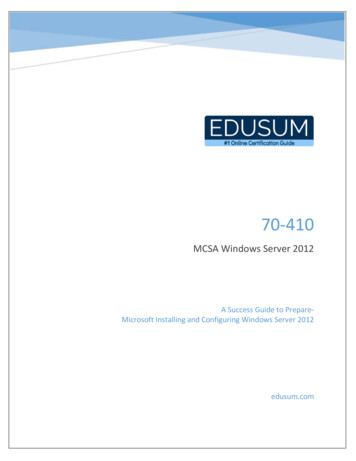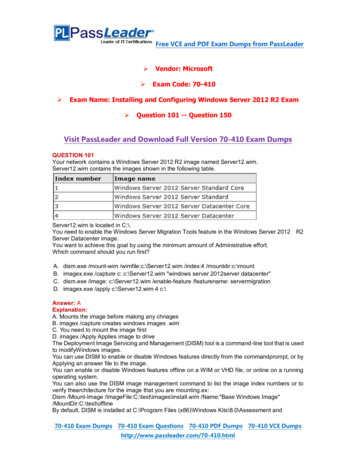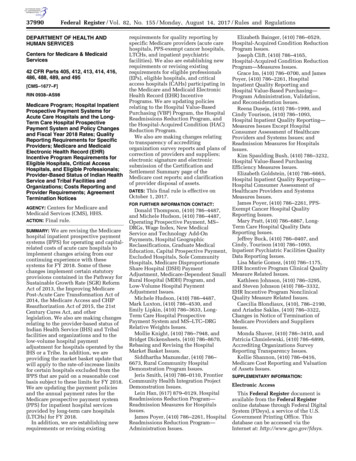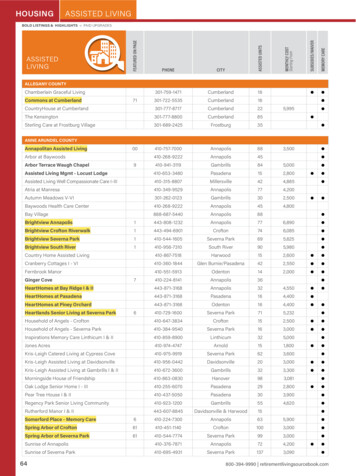
Transcription
Defense Transportation Regulation – Part IVPersonal Property21 April 2014CHAPTER 410SPECIALIZED PROCEDURESA. UNUSUAL OCCURRENCES1. This paragraph applies to all unusual occurrences including, but not limited to, the following:a. Natural Disasters (such as floods, fires, storms, earthquakes).b. Strikes, labor disputes, work stoppages.c. Civil disturbances.d. Unlawful entries, vandalism, theft.e. Seizure of a Transportation Service Provider (TSP) facility for failure to pay just debts.f.Closure of a TSP’s/contractor’s facility due to a court order.g. TSP service failure/cessation of operations/bankruptcy. (See Para. C.)h. Mold prevention and remediation (See Para. E.)2. PPSOs who receive notification of an unusual occurrence (as defined above) must comply withthe following actions:a. Immediately notify the DOD Component and SDDC/Operations Team telephonically andimmediately follow-up by electronic means by reporting the following information:(1) Type and date of the unusual occurrence.(2) Extent of known damage.(3) Geographic areas currently affected and/or those that may be affected.(4) Installations affected.(5) Names and addresses of all facilities affected and those that may be affected. IncludeTGBL TSP/agent facilities, NTS, and DPM facilities.(6) Number of shipments involved by Service/Agency.(7) Current locations of the affected shipments.(8) Destination of the affected shipments.(9) Additional information unique to a strike situation.b. The PPSO will provide support and request additional installation agencies to support anyand all actions identified above. During unusual occurrences affecting an installation,normally the on-scene CDR takes charge to provide protection to all affected resources undergovernment control or under control of a government contractor.c. In the event that a DOD-approved personal property facility or equipment used in commercehas been affected by the occurrences identified above, the PPSO and the TSP, with support ofthe claims personnel, must:(1) Determine the extent of damage, photograph conditions, and record findings.(2) Determine items that may be salvaged and those that require unpacking, drying,cleaning, or repacking.IV-410-1
Defense Transportation Regulation – Part IVPersonal Property21 April 2014(3) Contact the customers involved and give them the opportunity to inspect their propertyand provide disposition instructions (i.e., discard or deliver to residence).(4) When the customers are not available to inspect their damaged shipments, determinewhat items are damaged beyond repair/salvage. Damaged beyond repair items, otherthan those with intrinsic or sentimental value, must be disposed of with Staff JudgeAdvocate (SJA)/claims office approval. Notify the customer in writing of the loss andprovide instructions to file a claim.(a) The line-haul TSP involved is responsible for the removal/disposal of that propertydamaged beyond repair.(b) If no TSP is involved, the PPSO must dispose of the property IAW Service/Agencydisposal/salvage regulations. Where items can be repaired/salvaged, notify thecustomer and request instructions on repair/disposal. Do not dispose of damagedreparable property without the customer’s consent.(5) Contact the local SJA/claims office for instructions concerning personal property that isdamaged while en route to final destination.(6) Provide the customer with as much evidence as available to support the customer’sclaim.d. For the following unusual occurrences, PPSO personnel are responsible for verifying thatTSPs/agents have completed the following actions:(1) Theft/Vandalism:(a) Notify the law enforcement agency(s).(b) Provide 24-hour security.(c) Advise the insurance company.(d) Ensure security devices (doors, locks) are properly replaced/repaired.(e) Ensure structural damage is repaired.(f) Provide a detailed report of loss/damage.(g) As necessary, begin unpacking/repacking of affected goods. Opened cartons mustbe repacked, resealed and marked “inspected”.(h) Clean/repair items. Records must be kept of all items sent out for repair or drycleaning.(i)Obtain a copy of the police report.(j)Prepare a written report within 10 working days (or as otherwise directed by thePPSO) of all known facts and events in chronological order. Include a statementfrom each employee involved.(2) Flood/Storm/Water or Fire/Smoke Damage:(a) Take actions to prevent additional damage.(b) Provide 24-hour security.(c) Advise the insurance company.(d) Begin unpacking, inspecting, drying, and repacking of affected goods. Cartonsopened must be repacked, resealed, and marked “inspected”.IV-410-2
Defense Transportation Regulation – Part IVPersonal Property21 April 2014(e) Clean/repair items. Records must be kept to identify all items sent out for repair ordry-cleaning.(f) No items must be discarded until advised to do so by the PPSO.(g) Provide a detailed report of loss or damage.(h) Prepare a written report within 10 working days (or as otherwise directed by thePPSO) of all known facts and events in chronological order. Include a statementfrom each employee involved.(i)Obtain a copy of the fire inspector’s report.e. Areas disrupted by a strike or work stoppage.(1) In addition to the information required in Para. A.2.a above, also provide the following:(a) Labor and management contacts.(b) Main issue in dispute.(c) Date disruption began or may begin.(d) Local union involved, names, and telephone numbers of union officials.(e) Preliminary evaluation of the situation.(2) Impartiality in Merits of Labor Disputes. The FAR specifies that militaryrepresentatives must remain impartial in labor disputes. They must refrain from taking aposition on the merits of any labor dispute and must refrain from the conciliation,mediation, or arbitration of such disputes. The PPSO, however, must establish andmaintain contact with individuals involved in disputes to ensure that they are taking allpossible actions to avoid delays and stoppages in the movement of personal property. Ifpossible, the PPSO must attempt to obtain a voluntary agreement between managementand labor that permits the continued movement of personal property shipments duringthe labor dispute. If a general agreement cannot be reached, the PPSO must seek anagreement for the movement of those shipments required to relieve hardships imposedupon customers. In either case, the PPSO’s actions may not involve, or appear toinvolve, the PPSO in the merits of the dispute.3. Actions to be taken by installation CDRs. The CDR of an installation in an area by a strike,embargo, or work stoppage must determine those affected shipments that causes extreme personalhardship to the customer and requires special arrangements for release or delivery. Names of thecustomers and the reasons, in detail, for the declared hardships must be furnished to the SDDCdesignated representative with information copies to Service HQ. Before identifying an affectedshipment as a hardship case, the PPSO must coordinate with the installation CDR to attempt toprovide the customer or the customer’s family whatever resources may be available, includinggovernment household furnishings and other light housekeeping items, to alleviate the potentialhardship. In addition to notification of hardship cases, specify whether military personnel andequipment under control of the installation must be made available to remove such shipmentsfrom the affected facilities.IV-410-3
Defense Transportation Regulation – Part IVPersonal Property21 April 20144. Actions to be taken by SDDC. Upon notification of an emergency condition affecting orexpected to affect the movement or storage of personal property shipments, the following actionsmust be taken:a. Immediately notify USTRANSCOM J5/J4 and the DOD/ USCG Components of the nature ofthe unusual occurrence, the extent of the disruption, and the area affected. When warrantedby the nature of the situation or at the request of USTRANSCOM, submit periodic progressreports pending return of the area to a normal condition.b. Provide immediate traffic management guidance to the PPSO or PPPO nearest the site of theoccurrence and ensure compliance with the provisions of Para. A.2.a.c. Advise all PPSO and military ocean and air terminals of the nature of the occurrence and thecapability of installations in the affected area to receive personal property shipments.d. Provide instructions for disposition of shipments currently in transit to the affected area.e. Provide assistance to the responsible PPSOs in the diversion or reconsignment of personalproperty shipments to temporary storage areas and direct the relocation of personal propertyshipments.f.Authorize the PPSO to use TSPs’ and TSPs’ agents’ facilities located outside the AOR toprevent service failures.g. During a strike or work stoppage, appoint a strike coordinator to maintain contact with thePPSO, union officials, and management to assist in the movement of hardship cases. Uponnotification from a PPSO that a customer’s frustrated shipment has been declared a hardship,prepare electronic notification to SDDC (information copies to the Service/Agency HQsresponsible for the installation) including, but not limited to, the following:(1) A statement that the CDR of the affected installation has determined that a hardshipexists. For each hardship case, provide the customer’s name, rank/grade, SSN, branch ofService/Agency, and describe in detail the existing hardship.(2) Notification of whether the CDR of the affected installation must provide militarypersonnel and equipment to remove shipments from the affected facilities to alleviatehardship cases.(3) Notification that union and management officials agree to removal of such shipments bymilitary personnel and equipment.(4) A statement that a uniformed military officer and a union representative must be presentduring removal of personal property shipments and that the use of force or theappearance of force must be avoided, as well as any action that might affect ongoinglabor negotiations. In the event of difficulty, removal efforts must be suspended andmilitary personnel removed, and the situation must be reported to SDDC. Theconcurrence of the responsible SJA must be secured before the above notification isreleased.5. SDDC and USTRANSCOM. Upon receiving notification of an emergency condition that affects,or can be expected to affect, the movement or storage of personal property shipments, SDDC,after consultation with the SDDC SJA and USTRANSCOM, must:a. Issue specific instructions to responsible elements to ensure the continued movement andsecurity of personal property shipments when a major unusual occurrence encompasses awidespread area.IV-410-4
Defense Transportation Regulation – Part IVPersonal Property21 April 2014b. Issue worldwide instructions for disposition of shipments destined to affected areas whererestrictions on incoming shipments have been imposed.c. Provide necessary guidance for the release and movement of shipments to alleviate reportedhardship cases.d. Advise each Service/Agency HQs of the number of shipments involved, by Service/Agency,and provide information concerning the status of each shipment.e. Request approval of the assistant secretary of the military department responsible for anaffected installation to use installation vehicles and uniformed personnel for removal ofshipments required to alleviate hardship cases.f.Issue specific guidance and instructions to responsible elements to minimize the effects uponthe movement of personal property in the event of an unusual occurrence involving majorsegments of the transportation industry (such as longshoremen or maritime strikes).g. Coordinate with the Service/Agencies for the diversion to other codes/modes those personalproperty shipments in jeopardy of missing the RDD.h. Direct the TSP or warehouseman to take immediate action to account for, secure, protect, andcontrol all shipments.B. PERSONAL PROPERTY SHIPMENTS OF DECEASED CUSTOMERSThis paragraph sets forth policy and procedures for transportation of personal property of deceasedcustomers. It prescribes procedures to be followed at both origin and destination and designatesresponsibilities for notification and shipment monitoring. This paragraph applies to all methods andmodes of shipment of personal property for deceased customers. For entitlements please refer to theJFTR and JTR. The term “BLUE BARK” must be used to designate a personal property shipment ofa deceased customer.1. Documentation required to support the movement of personal property belonging to a deceasedcustomer is identified in Chapter 401. The PPSO must coordinate with the casualty assistanceofficer/mortuary officer to ensure they have complied with the DOD Component publicationsprior to arranging or effecting the movement of personal property.2. Origin PPSO. In the case of a BLUE BARK shipment, the origin PPSO must:a. Mark the words “BLUE BARK” in a conspicuous place on all shipping documents.b. Notify the destination PPSO by electronic means of the impending BLUE BARK shipment.The destination PPSO must be provided, as a minimum, the consignee’s name and address,the RDD, and the name of the TSP to which the shipment was tendered.c. Send copies of all documentation (annotated with the term “BLUE BARK”) to the destinationPPSO. Advance documentation must be provided in a timely manner to allow the destinationPPSO sufficient time to contact the TSP and consignee before arrival of the shipment.d. The destination PPSO must:(1) Contact the delivering TSP and the consignee upon receipt of advance documentation toeffect coordination of the delivery (no direct delivery authorized),(2) Inform the casualty assistance officer of the projected shipment delivery.(3) Inspect the shipment upon delivery and remain at the delivery site to record damages andprovide assistance.IV-410-5
Defense Transportation Regulation – Part IVPersonal Property21 April 2014C. TSP BANKRUPTCY/REVOCATION/DISQUALIFICATION PROCEDURES1. SDDC must establish internal procedures to take action to protect the US Government and theproperty belonging to DOD Component’s customers in all TSP bankruptcy/revocations anddisqualifications. These procedures must include a process to ensure that the DOD Component’sclaims services and finance centers receive prompt notice of any bankruptcy filing.2. Action Taken by the PPSO.a. Identify/locate all shipments tendered to the TSP (i.e., origin, in-transit, destination).b. Provide SDDC with a list of all shipments that have not arrived at destination.c. Comply with SDDC instructions to effect onward movement and issue all documentationnecessary to complete movement of shipments frustrated in their AOR (to include thoseshipments at origin or destination port agent facilities ready for onward movement).d. International shipments frustrated at commercial ports due to nonpayment of charges refer tothe International Tender.e. Upon notification from SDDC to terminate shipments of a bankrupt TSP, must immediatelyattempt to locate all shipments within their AOR.(1) Shipments Still at Origin.(a) Shipments that have been awarded but not picked up must be pulled-back and reawarded to another TSP.(b) Shipment that have been picked up and are at the origin agent’s facility must bepulled-back and rebooked with another TSP. State in the remarks block of the BLthe rationale for shipment termination and cross reference BLs.(2) Shipments at Destination.(a) Shipments at the TSPs destination agent’s facility. Terminate the shipment byissuing a SF 1200, Government Bill of Lading Correction Notice, Figure 410-1,effective the date the shipment was received by the destination agent. State in theremarks section, “BL terminated at destination agent due to the, i.e., non-use,disqualification of (TSP name).” For ITGBL shipments moving under SFRs thatinclude unpacking, show SFR reduction for nonperformance of unpacking, i.e.,“International Tender number (state number) applies ( ) per (net or gross)cwt reduction to SFR. HHG containers which are the property of (TSP name) mustbe made available to (TSP name) or their designated agent upon delivery of theshipment.” Use DPM TSP for all further services or pay the destination agent forservices performed as follows:1Army, Air Force, Navy, and Coast Guard: Pay the destination agent on a localpurchase order or blanket purchase agreement.2Marine Corps: The destination agent must submit an invoice for servicesperformed to the destination PPSO for certification and then forward theinvoice to the Commanding General, Marine Corps Logistics Base (Code 470),Albany GA 31704, for payment with a copy of the DD Form 1299, Applicationfor Shipment and/or Storage of Personal Property, Figure 410-2, Orders, DDForm 619, Statement of Accessorial Services Performed, Figure 410-3, SFForm 1200. Government Bill of Lading Correction Notice, Figure 410-1; andterminated BL.IV-410-6
Defense Transportation Regulation – Part IVPersonal Propertyf.21 April 2014Intermediate Locations.(1) Shipments on Hand at Intermediate Locations. The PPSO responsible for the areawhere the property is located (to include shipments at origin or destination port or portagent facilities) must terminate the shipment by issuing a SF 1200, to be effective thedate shipment was received. State in the remarks section, “BL terminated at (state pointwhere shipment was terminated) due to the (reason for termination (i.e., non-use,disqualification) of (TSP name).” “(TSP name) can bill for services performed to(termination point).” Issue a new BL for onward movement using the followinginstructions.(a) Shipments at the Destination Port or Destination Port Agent. Tender the shipmentas a DPM shipment. Issue a new BL to the new TSP to the final destinationshowing origin (Block 19) as the point where the shipment is located. Crossreference the old and the new BL and TSP names on both the BL correction noticeand the new BL. State in the Remarks Section (Block 25) of the new BL, “Onwardmovement of frustrated shipment due to (i.e., non-use, disqualification) of (TSPname),” and “HHG containers which are the property of (TSP name) must be madeavailable to (TSP name) agent at destination upon delivery of the shipment.” If theshipment is being held by the port agent for payment of port services, arrange forpayment to the port agent by a local purchase order. For overseas PCS shipments,the above information must be entered on the freight warrant or other documentissued to complete movement to destination.(b) Shipments at the Origin Port or Origin Port Agent. Tender the shipment to a newITGBL TSP with cost favorable rates from the termination point. In the RemarksSection (Block 25) show the SFR reduction for non-performance of packing (i.e.,“International Tender number (state number) applies. ( ) per (net or gross)cwt reduction to SFR.”) The new TSP must obtain new weight tickets. State inRemarks Section (Block 25) of the new BL, “Onward movement of frustratedshipment due to (i.e., non-use, disqualification) of (TSP name),” and “HHGcontainers which are the property of (TSP name) must be made available to (TSPname) agent at destination upon delivery of the shipment.” Cross-reference the oldand the new BL and TSP names on both the SF 1200 and the new BL.(2) Shipments Held by Line-haul/Flatbed/Motor Freight TSPs at Origin Port for Payment ofLine-haul Charges.(a) The PPSO/port receiving information that a shipment is being held at the port mustnotify the origin PPSO who must terminate the original BL at the origin agent’swarehouse by issuing a SF 1200. State in the Remarks Section “BL terminated at(name of origin agent) due to (i.e., non-use, disqualification) of (TSP name).”“(TSP name) can bill for origin services only in accordance with item (itemnumber) of International Tender”(b) The origin PPSO must issue a new BL to a new TSP from the origin agent’swarehouse to the final destination. Advise the new TSP that the shipment is beingheld by line-haul/flatbed/motor freight TSP at the origin port (identify specificlocation) and the new TSP must be required to pay the TSP holding the shipmentfor the line-haul charges to the port and arrange for onward movement to the finaldestination. BL Remarks Section (Block 25) must show SFR reduction for nonperformance of packing (i.e., “ International Tender number (state number) applies.( ) per (net or gross) cwt reduction to SFR.”) Also state in the RemarksSection, “HHG containers which are the property of (TSP name) must be madeIV-410-7
Defense Transportation Regulation – Part IVPersonal Property21 April 2014available to (TSP name) agent at destination upon delivery of the shipment,” and“Onward movement of frustrated shipment due to (i.e., non-use, disqualification)of (TSP name).” Cross-reference the old and the new BLs and TSP names on boththe SF 1200 and the new BL. The new TSP must obtain new weight tickets.(3) Domestic Shipments Abandoned/Frustrated at a Point En Route to Final Destination.The PPSO responsible for the area where the shipment is frustrated must terminate theoriginal BL at the point where the shipment is located by issuing a SF 1200. State in theRemarks Section (Block 25), “BL terminated at (termination location) due to (reason fortermination) of (TSP name).” “(TSP name) can bill for services to (shipment location).”Issue a new BL to a new TSP for movement to the final destination showing the originas the point where the shipment is located and state in the Remarks Section (Block 25),“Onward movement of frustrated shipment due to (i.e., non-use, disqualification) of(TSP name).” For Code 2 (containerized) shipments, state in Remarks Section (Block25), “HHG containers which are the property of (TSP name) must be made available to(TSP name) agent at destination upon delivery of the shipment,” and “No packingservices performed. TSP can bill for line-haul and services certified by PPSO.” Crossreference the old and the new BLs and TSP names on both the SF 1200 and new BL.The TSP must obtain new weight tickets.(4) Domestic Shipments Moving by an Alternate TSP for (TSP Name) That BecomeFrustrated En Route. The PPSO receiving information that a shipment is being heldmust notify the origin PPSO who must cancel the original BL at origin by issuing a SF1200. State in Remarks Section (Block 25) “BL canceled due to (i.e., non-use,disqualification) of (TSP name).” Issue a new BL to the alternate TSP from origin tofinal destination. Cross-reference the old and the new BLs on both the SF 1200 and thenew BL. If the alternate TSP does not have rates on file, move under the TSP’scommercial tariff. The new TSP must obtain new weight tickets.(5) Domestic mobile home or boat tow-away shipments must be handled IAW the“Termination of Service” item in the Mobile Home Solicitation.g. Shipments Detained by Ocean TSPs for Nonpayment of Ocean Charges.(1) Unless otherwise directed by SDDC, the SDDC designated representatives mustascertain those shipments being held at the ports in their AOR for nonpayment of oceancharges and must notify SDDC to solicit OTO rates. Coordination with SDDC may benecessary to determine whether port solicitations or individual shipment OTOs arerequired. Requests for individual OTOs must include the customer’s name/rank orgrade/SSN, code of service, BL, RDD, origin port, present location of shipment,pieces/weight/cube, ocean TSP/vessel/voyage number, ocean bill of lading number,container number, final destination, and responsible destination TO.(2) SDDC must solicit competitive OTO rates by individual ports or, where volume islimited, by individual shipment rather than by port. TSPs that bid must be required topay the ocean charges and all other charges that may have accrued (i.e., demurrage,storage, port handling, drayage), and complete movement to final destination.(3) When the OTO bids have been processed, SDDC must provide the destination PPSOand SDDC designated representatives, by electronic means, the names of the TSPsselected to move the shipments. If the solicitation is by port, the primary and secondaryTSPs selected to service each port, their OTO tender number, and the rate informationmust be provided.IV-410-8
Defense Transportation Regulation – Part IVPersonal Property21 April 2014(4) Each destination PPSO that has shipments in this category is responsible for issuing alldocumentation for shipments destined to their activity. If the solicitation is by port, theSDDC designated representative must provide the responsible destination TOs a list ofall shipments being held at the various ports that are destined to their activity. The listmust include the customer’s name, BL number, origin port, and present location ofshipment. Upon receipt of this information, each destination TO must be responsible forissuing the following documents to complete movement of these shipments.(a) Issue a SF 1200 to terminate the original BL at the origin port. State in theRemarks Section (Block 25) “BL terminated at (name of origin port) due to the(i.e., non-use, disqualification) of (TSP name).” “(TSP name) can bill for servicesto the origin port only in accordance with items (item numbers) of ITGBL RateSolicitation number (number).”(b) Issue a new BL to the OTO TSP. Cross-reference the old and the new BLs and theTSP names on both the SF 1200 and new BL. In Block 19 of the new BL show thename of the origin port where the original BL was terminated and state in theRemarks Section (Block 25) the current location of the shipment (i.e., Port ofBaltimore). In “Consignee” (Block 18) show the final destination of the shipment.State in “Remarks” Section, (Block 25) “HHG containers which are the property of(TSP name) must be made available to (TSP name) agent upon delivery ofshipment” and “Onward movement of frustrated shipment due to (i.e., non-use,disqualification) of (TSP name). All ocean charges, including storage and drayage,must be paid by Finance on a submission of a paid invoice.” In “Tariff or SpecialRate Authorities” Section (Block 31) show the OTO tender number and OTO rate.If the solicitation is by port, show the OTO tender number and statement “SeeRemarks Block.” In Remarks Section (Block 25), show the rate informationprovided by SDDC. The OTO TSP must obtain new weight tickets. For a pickupdate, use the date the BL was issued. Establish the RDD based on the pickup date,plus five days.h. Recovery of Excess Funds Expended by the DOD to Complete Movement.(1) All PPSOs, immediately upon completion of retendering of all frustrated shipmentsmust forward a list of all shipments retendered by their activity to SDDC. Thefollowing information must be included in the lists.(a) Customer’s last name, first name, MI.(b) Rank or Grade.(c) SSN/Employee Identification Number(d) Branch of Service/Agency.(e) Original BL number.(f)Name of new TSP.(g) New TSP BL number.(h) Paying finance office.NOTE: If a purchase order or freight warrant was issued to cover payment of servicesperformed, indicate this and provide a copy of the paid bill to SDDC.IV-410-9
Defense Transportation Regulation – Part IVPersonal Property21 April 2014(2) SDDC must consolidate all data for their use in the audit of these shipments for recoveryof excess funds expended by the DOD to complete movement of the shipments.(3) SDDC must provide the results of the recovery actions to the Services involved.D. EMERGENCIES INVOLVING SHIPMENTS IN NTS (CONUS)1. Purpose and Scope. This paragraph prescribes procedures and provides guidance for thenotification to SDDC, of any incident at a commercial storage facility that affects, or is likely toaffect, the storage of personal property. It applies to any incident (such as flood, fire, andunlawful entry) that causes, or is likely to cause, loss or damage to stored personal property. Italso applies to bankruptcy proceedings or any adverse actions against or by a storage providerthat impedes or prevents the removal of goods from storage or result in loss or damage to storedpersonal property.2. Actions to Be Taken by the PPSO.a. Upon becoming aware of an incident or situation that is causing, or is likely to cause, loss,damage, or frustration of personal property shipments in storage, the PPSO must immediatelynotify the responsible SDDC RSMO or theater SDDC office. Incidents or situations to bereported include, but are not limited to, the following:(1) Natural disasters (such as floods, fires, and storms).(2) Unlawful entries.(3) Strikes, work stoppages, or embargoes.(4) The seizure of a storage facility for failure to pay just debts.(5) Closure of a storage facility in compliance with a court order.(6) Action on the part of the storage providers creditors to file a bankruptcy petition.(7) Failure on the part of the storage provider to fulfill all the terms and conditions of theTOS for storage of HHG and related services (Appendix J).3. SDDC Notification Furnished to USTRANSCOM and the DOD/USCG Components. To informthe DOD of unusual circumstances that may result in the filing of a large number of claims forloss or damage to stored personal property shipments, the CDR, SDDC, must provide each DODcomponent claims office a copy of the RSMO or theater SDDC offices final report.E. MOLD PREVENTION AND REMEDIATIONThe TSP may be liable for additional damage that results from its failure to take reasonable steps tomitigate the extent of the loss. For example, if a shipment is damaged by water, the TSP, as soon aspractical, should attempt to clean and dry the items, rather than allow further damage (e.g., rust,warping, or mildew), to develop from prolonged exposure to dampness. The PPSO/PPPO may directthe TSP to undertake specific mitigation work, or may authorize payment for mitigation work, subjectto later determination of whether the government or the TSP is liable for the cost. The cost of anysuch mitigation efforts not paid for by the government is deducted fr
Personal Property IV-410-2 (3) Contact the customers involved and give them the opportunity to inspect their property and provide disposition instructions (i.e., discard or deliver to residence). (4) When the customers are not available to inspect their damaged shipments











